
Types of furniture fronts.
- today
- label News
- favorite 0 likes
- remove_red_eye 723 views
- comment 0 comments
Wooden fronts
The most noble of furniture fronts are wooden ones, which retain the appearance and properties of wood. They are usually made using one of ten different types of wood, the most popular of which is classic oak. For those who are not impressed by the characteristic open grain of oak, cherry may be an interesting proposition. Wooden fronts can be subjected to various types of processing, e.g. painting with multi-component varnish in a uniform color. Such a finish is often used in Provencal-style furniture, which is painted in light colors: white, beige or vanilla. Wood can be painted with stain in a virtually unlimited number of colors. Popular effects include aging the wood, e.g. by carving scratches and recesses in it, patination, emphasizing the wood structure.
Wood has the advantage that it can be adapted to virtually any style: whether modern, rustic, Provençal or vintage, and can also be given any shape, e.g. bent. The disadvantage is the need for careful care and protection of the wood, as well as the high price. Wooden fronts are much more expensive than varnished, laminated or veneered ones.
The beauty of natural wood does not need any recommendation. The unique grain, colors and play of light are magic. Wooden fronts in your furniture make the interior stylish and classic regardless of changing fashion and current trends.
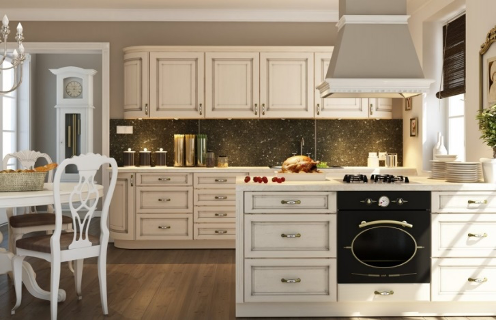
Veneered fronts
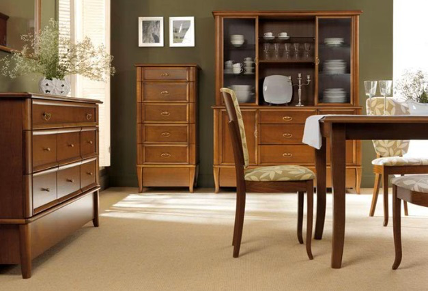
Veneer is a natural veneer, i.e. a thin "slice" of wood glued to the surface of a furniture board or MDF board. Various thicknesses of veneer are used on the surface of furniture - from 0.6 mm to 1.5 or even 2 mm. Unlike artificial surfaces, e.g. melamine boards, veneer retains the properties of wood. Veneer, like wood, is diverse in terms of color, staining, and is sensitive to moisture and sunlight. Veneers are most often made from trees such as oak, beech, pine, or ash.
Currently, exotic veneers, modified from rosewood, teak, ebony are also available on the market. Veneer is made of quality-sorted wood, which is why veneered furniture has fewer defects than furniture made of solid wood, such as knots and heartwood. Wood adjusts its volume to air humidity, thanks to the use of veneer, furniture does not have cracks so characteristic of wood working in changing weather conditions. Veneered furniture can have any size, its only disadvantage is the lack of possibility of making spatial decorations, which is why veneered fronts are most often smooth or in the form of a frame with a panel. Exotic veneers allow you to obtain interesting aesthetic effects of furniture, due to unusual grain and natural shade. The outer layer of veneered fronts is protected with varnish, matt or glossy, thanks to which you can obtain a front in a classic or modern style.
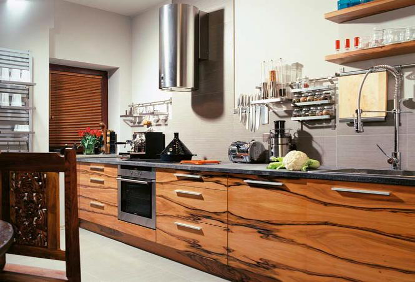
Lacquered fronts
These are primarily colors that introduce a lot of freshness, fantasy, modernity and aesthetics to the interior. Made of MDF boards, they can be varnished in gloss, matt or semi-matt. The rich color palette of varnishes means that the only limitation is your imagination.
High-gloss lacquered furniture enjoys unwavering popularity. Glossy surfaces look impressive both in open spaces, becoming a representative element of the decor, and closed, optically enlarging the room. People who are afraid of glossy fronts can opt for a matte finish. Subdued matte shades allow for simplicity of form, emphasizing its unique character and giving the impression of subtlety. Matte fronts are great for spacious kitchens, they match interiors in any style - from modern to traditional arrangements.
A big concern with lacquered fronts, especially in glossy kitchen furniture, are visible fingerprints on the fronts, unfortunately there are no such fronts that do not need to be cleaned. Both matt and gloss lacquered fronts are very easy to clean, just wipe with a soft cloth without any careful maintenance. An additional advantage is the possibility of making lacquered fronts with a milled handle, the advantage of which is a smooth, uniform surface, which works well in the case of modern, minimalist interiors.
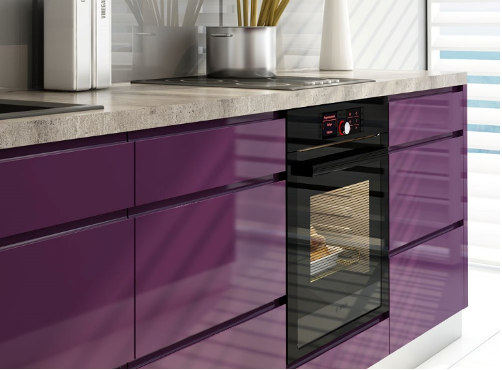
Glossy acrylic fronts
Acrylic coated board is a great option for people who dream of glossy furniture, but think that a varnished surface is too expensive. Furniture acrylic can be used in kitchen, bathroom, living room and exhibition furniture designs. In the latter case, it will be an element of shop equipment. The depth of gloss (so-called glass effect) of acrylic coated elements is unattainable in the case of varnish. The colour shine is very deep. A 1.4 mm thick acrylic coating gives you the opportunity to achieve a glossy effect that is unique. Acrylic fronts, however, have their drawbacks, namely the edges are covered with ABS edging, often in a contrasting colour. Additionally, with acrylic, we do not have such a wide range of colours as the possibility of varnishing fronts gives us, and we are limited to a glossy finish, because acrylic fronts do not come in a matt finish.

Laminated MDF fronts
The basic raw material is an MDF board, which is processed by milling and gluing with single-colour, wood-like, matt or glossy PVC foils. Elements covered with foils can be additionally patinated and varnished. The foil is applied to the form together with the edges, creating a front with nicely finished edges, i.e. in the case of varnished fronts. Unfortunately, in the case of this type of fronts, durability fails, because the foil often peels off after some time due to too high temperature or humidity in the room. Kitchen fronts near the oven and in bathroom cabinets are particularly vulnerable. Glossy foils used as a cheaper alternative to varnished fronts do not have a mirror effect and scratch easily. A big advantage, however, is the wide selection of patterns imitating the structure of wood at an attractive price, the possibility of manual patinating of the foil - thanks to which you can obtain retro-style furniture not necessarily at the price of wooden ones. An additional advantage is the possibility of obtaining thickened elements with various shapes and decorations, not only flat surfaces as in the case of veneered fronts.
In large fronts, additional reinforcing profiles (so-called muntin bars) are used running through the centre of the front, which are intended to strengthen the structure and at the same time increase its aesthetic value.
An important element of each front is the filling. The most commonly used type of filling is glass: transparent, matt type lakomat or satinato, smoked so-called antisol, colored lacquered (lacobele) or matt (matelac) and mirrors. Glass fillings so-called aluglass are also available, i.e. a combination of clear glass with a special multi-colored aluminum foil with rich ornamentation - which additionally acts as safety glass and is an excellent alternative to traditionally used laminated glass.
We must be aware that every glass carries the risk of breakage. To minimize it, manufacturers suggest using safety glass instead of regular glass in one of two forms: tempered or glued with a special safety foil. Aluminum can be used in interiors decorated in a modern, minimalist style.
Fronts made of MDM board veneered with PVC foil are one of the most popular solutions today. The possibility of obtaining various shapes and a very wide range of finishing options, both in uniform colors and with wood grain reproduction, make veneered board a great material for furniture elements. It has good mechanical parameters, quite high resistance to moisture, and a big advantage is durability. Unpleasant surprises related to its use, which we may encounter if we come across a product of poorer quality, in which the manufacturer has saved on glue, are the tendency of the foil to peel off and sometimes color fading. Problems may become more severe when poorly finished furniture is too close to a heat source, such as a stove or oven.
MDF board can also be varnished with special acrylic varnishes in a wide range of colours. This is a solution for those who do not care about the imitation wood finish, but want to obtain a uniform matt, glossy or polished surface. Such fronts work well in bathrooms and other rooms with increased humidity. Since they must have some weakness, they are susceptible to scratches, so they are not very suitable for very intensively used furniture, especially if there are children and ubiquitous animals in the house.
One of the most durable and very popular solutions used in furniture is fronts made of laminated chipboard or MDF. The main difference is that while MDF allows for milling of the surface, chipboard can only be uniformly smooth. This is due to the much higher density and fibrous, uniform structure of MDF boards.
The technology of producing laminated boards consists in pressing resin-impregnated paper onto the board surface. The process takes place at a temperature of over 200°C, thanks to which fronts and bodies made of this material demonstrate quite high heat resistance: they can easily be used as an oven casing, for example. They are also resistant to moderate humidity, which occurs in the kitchen, provided that the edges through which humidity has a chance to get into the board have been sufficiently protected with an appropriate type of edge, which also determines the aesthetic value:
- melamine edge based on impregnated paper, used less and less often due to the low degree of edge protection;
- PVC edge with relatively high resistance to mechanical damage and moisture can be from 0.5 mm to 3 mm thick. It works great in both fronts and furniture bodies.
- ABS edging, more ecological than PVC, a solution with similar parameters, increasingly used.
- aluminum profiles, the already mentioned solution with increased resistance to mechanical damage and moisture, gives the furniture a modern look.
In the bathroom, on the other hand, special moisture-resistant laminated boards should be used, also connected to an appropriate edge.
Resistance to alcohol and acids is also higher than in the case of boards covered with PVC foil. A wide range of patterns and surface structures is available: smooth, pearly, matt, or with a structure imitating real wood. Remember also that laminated boards are not suitable for use as work surfaces, e.g. kitchen countertops. It should also be remembered that only minor damage to the fronts of such boards can be filled with special fillers.
The cheapest on the market are fronts made of chipboard, reinforced with an MDF board frame finished with the so-called finish foil, i.e. thin, printed pre-impregnation or decorative paper. Here, it is also possible to obtain the effect of a uniform smooth surface, matte, glossy or imitating the structure of wood. However, it is difficult to talk about resistance to moisture, acids or mechanical damage. That is why they are most often used in box furniture for living rooms, and not, for example, in the kitchen.
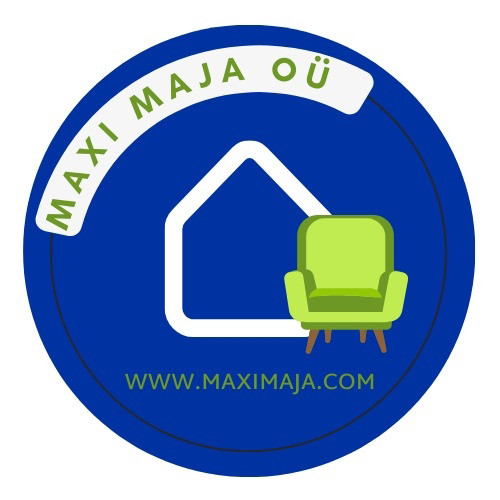
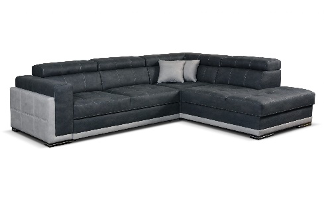
Comments (0)